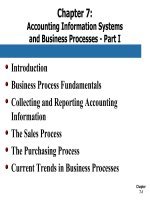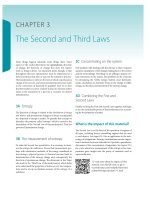Ecomomics evelopment 10th y p todaro and smith chapter 07
Bạn đang xem bản rút gọn của tài liệu. Xem và tải ngay bản đầy đủ của tài liệu tại đây (863.63 KB, 38 trang )
Chapter 7
Urbanization and
Rural-Urban
Migration: Theory
and Policy
Copyright © 2009 Pearson Addison-Wesley. All rights reserved.
Urbanization and Development
• Economic development causes urbanization
• There is a positive correlation with economic
development and urban population growth
Copyright © 2009 Pearson AddisonWesley. All rights reserved.
7-2
Urbanization and Development
Copyright © 2009 Pearson AddisonWesley. All rights reserved.
7-3
Urbanization Across
Time and Income
Copyright © 2009 Pearson AddisonWesley. All rights reserved.
7-4
Urbanization Trend
World urban population distribution (in billions)
2000
2025
World
3.2
5.1
MDCs
1.0 (31%)
1.1 (22%)
LDCs
2.2 (69%)
4.0 (78%)
Copyright © 2009 Pearson AddisonWesley. All rights reserved.
7-5
Distribution of Urban Population
Urban population shares of Asia and Africa are
expected to rise at the expense of Latin America:
2000
Africa
18%
2025
20%
Latin America
22%
15%
Asia
60%
65%
Copyright © 2009 Pearson AddisonWesley. All rights reserved.
7-6
Urbanization in the World
Copyright © 2009 Pearson AddisonWesley. All rights reserved.
7-7
Projected Urban and Rural Population
MDCs and LDCs, 1950-2030
Copyright © 2009 Pearson AddisonWesley. All rights reserved.
7-8
Most Populated Cities
• Of the 15 largest cities, 4 are in MDCs (LA, NY,
Tokyo, and Osaka) and 11 are in LDCs
• By 2015, the ranking of these largest cities will
change in favor of the LDCs (e.g., NY falls from
no. 3 to 11)
Copyright © 2009 Pearson AddisonWesley. All rights reserved.
7-9
Largest Cities in the World
Copyright © 2009 Pearson AddisonWesley. All rights reserved.
7-10
Mega-Cities:
Cities with 10 Million+ Inhabitants
Copyright © 2009 Pearson AddisonWesley. All rights reserved.
7-11
Size of Largest Cities
Copyright © 2009 Pearson AddisonWesley. All rights reserved.
7-12
Location of Migrant Workers
• Migrant workers move to nearby towns and large
cities, and especially the capital city
• They reside in slums and shanty towns where low cost
housing is available
Copyright © 2009 Pearson AddisonWesley. All rights reserved.
7-13
Slums in Urban LDCs
Copyright © 2009 Pearson AddisonWesley. All rights reserved.
7-14
Urbanization
The LDCs experience rapid urban population
growth because of
• Natural increase: birth rate > death rate
• Rural-urban migration: movement of rural workers to
urban areas
Copyright © 2009 Pearson AddisonWesley. All rights reserved.
7-15
Contribution of R-U Migration
• On average, about 50% of urban population growth of
the LDCs is due to R-U migration
• Rapid R-U migration has resulted in the construction
of slumps and shanty towns that house a large
percentage of urban population
Copyright © 2009 Pearson AddisonWesley. All rights reserved.
7-16
Extent of R-U Migration
Copyright © 2009 Pearson AddisonWesley. All rights reserved.
7-17
Components of Migration
Copyright © 2009 Pearson AddisonWesley. All rights reserved.
7-18
Dualistic Economic Structure
• Formal sector: organized and regulated economic
system (e.g., government agencies, banks); it
generates 2/3 of GDP
• Informal sector: fragmented and unregulated
economic system (e.g., street vendors, loan sharks);
it generates 1/3 of GDP
Copyright © 2009 Pearson AddisonWesley. All rights reserved.
7-19
Dualistic Labor Market
• Formal labor market: skilled labor (e.g., government
employees, teachers) and professionals with
education and license
• Informal labor market: semi-skilled and unskilled
labor (e.g., small business, street vendors)
Copyright © 2009 Pearson AddisonWesley. All rights reserved.
7-20
Urban Informal Sector
• Most rural migrants find jobs in the
“informal” urban labor markets
• The “informal” urban labor force is
a large component of the urban
labor force
Copyright © 2009 Pearson AddisonWesley. All rights reserved.
7-21
Informal Urban Labor Force
Copyright © 2009 Pearson AddisonWesley. All rights reserved.
7-22
Informal Employment
Copyright © 2009 Pearson AddisonWesley. All rights reserved.
7-23
Developing Urban Informal Sector
Advantages of investment in urban “informal”
sector
• Contributes to economic growth
• Requires small capital investment
• Requires low cost of training and education
• Supplies semi-skilled labor to industry
© 2009 Pearson Addison•Copyright
Uses labor-intensive
technology to create jobs
Wesley. All rights reserved.
7-24
Developing Urban Informal Sector
Disadvantages of investment in the urban
“informal” sector
• Induces R-U migration
• Exerts pressure on urban infrastructure
• Adds to pollution, congestion, and crime
Copyright © 2009 Pearson AddisonWesley. All rights reserved.
7-25









